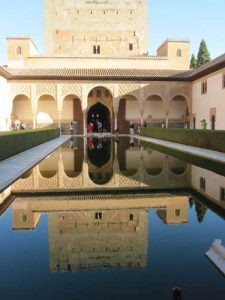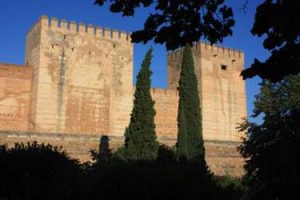La Alhambra de Granada (ADVANCED LEVEL)


- Remember, expect this to be challenging.
- First, read the English version.
- Next, read the Spanish version.
- See how many words and phrases you can pick out.
- Make sure to answer the questions to practice your reading comprehension, always using complete sentences.
The Alhambra of Granada (advanced level)
The city of Granada was the capital of the last Moorish kingdom in the Iberian Peninsula, the ¨taifa¨ of Granada. This territory included the current Spanish provinces of Almeria, Granada, Malaga and part of Cadiz and Jaen. It survived on its own paying tributes to the kings of Castilla until it surrended to the Catholic King and Queen on January 2 of 1492.
The Alhambra, the gem of Granada, was a complete city. Inside its walls there was all that it was necessary to live: military force, mesquite, residential and administrative palaces, zoco, vegetable and flower gardens. It was here where the king and the nobles of his court resided, as well as the soldiers in charge of guarding and the common people, whose work would take care of the necessities of the high class.
Despite this diversity, the city presents unquestionable esthetics, and its surroundings, the highest harmonic expression, often found in Granada, between manmade and nature.
It was the first nazarite king Muhamad I who founded the city in 1238, and his successors increased it until it was conquered by the Christians in 1492.
Alhambra means ¨The Red¨, the red castle, alluding to its red wall colors under the light torches at sunset.
The Alhambra, in the exterior, is sheer harmonic equilibrium for the senses. The green from the vegetation and the red walls seem to be coexisting from the very beginnings. The music of the water in the irrigation ditches, the nightingale songs among the trees, and the light, that light that seems to brighten everything, lifts the spirits when you visit. While watching this city we cannot help to understand the tears of Boabdil, the last Moorish King of Granada, when defeated by the Christians, he was obliged to abandon this place.
Like all Muslim architecture, the buildings within the Alhambra are harmonic but moderate towards the exterior. They may remind us of military buildings, without any kind of decorations. However, we must go inside, and walk around enjoying the numerous rooms in order to discover the most beautiful, oldest and better conserved Arabic palace in the world.
The rooms in the Palace of Comares are of special beauty. This was center of politic and administrative life, and built surrounding the Patio of the Arrayanes. Also of inmense beauty is the Palace of the Leones, the private residence of the Sultan (Harem) with the Patio of the Leones as the central piece.
East of the palaces, and separated by the gardens of the Partal, and the Cuesta of the Chinos, The Generalife, the summer residence of the Moorish kings, offers captivating gardens, fountains and ponds, a delicious atmosphere that is sure to capture visitors. They represent the exuberance, peace and refreshing life that contrasts the past life in the desert.
If the exterior of the Alhambra is peace and harmony with nature, it is the inside where the artistic Arabic spirit reaches its highest summits of aesthetic pleasure. The ambiance and the decorations transport us to past times in which stories and legends alike took place within these walls.
Strolling with time the interior of this place in the company of a guide our senses will become overwhelmed with beauty, enchantment and captivating personality of the art achieved by Muslim and Christians.
Once the visit is over and still impressed by the tour around this palace and gardens, we encourage you to pay a nocturnal visit to the Barrio del Albaicín Alto, North of the Alhambra. It is from this place where you can watch this red, majestic and enigmatic, and good guardian of secrets, intrigues and passions place. Only then, impacted by this vision that will forever stay with us, we will leave Granada…
La Alhambra de Granada (nivel avanzado)
La ciudad de Granada fue la capital del último reino moro de la Península Ibérica, la taifa de Granada. Este territorio comprendía las actuales provincias españolas de Almería, Granada, Málaga, parte de Cádiz y Jaén. Sobrevivió en solitario pagando tributos a los reyes de Castilla hasta que el 2 de enero de 1492 se rindió a los Reyes Católicos.
La Alhambra, perla de Granada, fue una ciudad en sí misma; dentro de sus murallas había todo lo necesario para su subsistencia: fortaleza militar, mezquita, palacios residenciales y administrativos, zoco, huertas y jardines. En ella habitaban los reyes y los nobles de su corte, los soldados encargados de la guardia y el pueblo bajo que con su trabajo atendía las necesidades materiales de los anteriores.
A pesar de esta diversidad, todo el conjunto posee una unidad estética incuestionable y, con su entorno, la más alta expresión armónica, tan frecuente en Granada, entre lo realizado por el hombre y la obra de la naturaleza.
Fue el primer rey nazarita Muhamad I quien la fundó en 1238 y sus sucesores la fueron engrandeciendo hasta su conquista por los cristianos en 1492
Alhambra significa “La Roja”, el castillo rojo, en alusión al color rojizo de sus muros a la luz de las antorchas con que se iluminaba al ponerse el sol.
La Alhambra, exteriormente, es puro equilibrio armónico para los sentidos: el verde de la vegetación y los muros rojizos parecen coexistir desde siempre, la música del agua en las acequias, los cantos de los ruiseñores en la arboleda, y la luz, esa luz granadina que todo lo anima y levanta el espíritu. Uno comprende, contemplándola, las lágrimas de Boabdil, último rey moro de Granada, cuando, derrotado por los cristianos, se vio obligado a abandonarla…
Como toda la arquitectura musulmana, los edificios que componen el conjunto de la Alhambra son armónicos pero sobrios exteriormente, nos recuerdan a meros edificios militares, sin concesiones a decoración alguna. Sin embargo, hay que penetrar en su interior y recorrer sin prisa sus numerosas estancias para descubrir el más bello, antiguo y mejor conservado palacio árabe del mundo.
Son de especial belleza por el encanto de sus estancias El Palacio de Comares, centro de la vida política y administrativa, edificado en torno al Patio de los Arrayanes y, El Palacio de los Leones, residencia privada del Sultán (El Harén) con el Patio de los Leones como pieza central.
Al Este de los palacios y separado de ellos por los huertos del Partal y la Cuesta de los Chinos, El Generalife, residencia de verano de los reyes moros, nos ofrece cautivadores jardines, huertos, fuentes y estanques; delicioso ambiente que atrapa al visitante: paraíso de exuberancia, paz y frescor que contrastan con la pasada vida en el desierto de este pueblo.
Pero si el exterior de La Alhambra es paz y armonía con la naturaleza, es en el interior donde el espíritu artístico árabe alcanza cotas difícilmente superables de goce estético, donde el ambiente y la decoración llevada al límite nos transporta a tiempos pasados y nos predispone a escuchar las historias y leyendas que sus muros encierran.
Entremos, recorramos sin prisas acompañados de un buen guía su interior y nuestros sentidos se verán colmados por la abrumadora belleza, el encanto y la cautivadora personalidad del arte hispanomusulmán que aquí alcanza cotas insuperables.
Después, impresionados todavía por el recorrido interior de sus palacios y jardines, hagamos una visita nocturna al barrio del Albaicín Alto, al Norte de La Alhambra, y contemplémosla desde allí rojiza y majestuosa, enigmática guardiana de secretos, intrigas y pasiones…. Sólo después, impactados con esta visión que nos acompañará toda la vida, podemos abandonar Granada…
Comprensión lectora
- ¿A qué país nos referimos cuando decimos La Península Ibérica?
- ¿Qué significa La Alhambra?
- ¿Quién fue el fundador de La Alhambra?
- Nombre algunas de las estancias principales de La Alhambra.
- ¿En qué ciudad se ubica La Alhambra?
- ¿Qué otros lugares de Granada se recomienda visitar?

